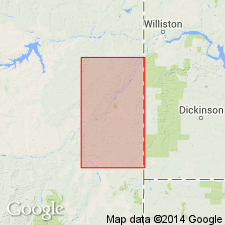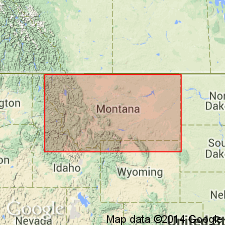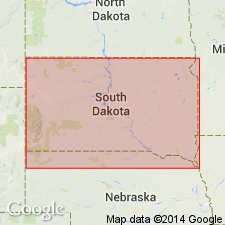
- Usage in publication:
-
- Colgate sandstone member*
- Modifications:
-
- Original reference
- Dominant lithology:
-
- Sandstone
- Shale
- AAPG geologic province:
-
- Williston basin
Summary:
Pg. 189-198. Colgate sandstone member of Lance formation. White and yellowish sandstone, 185 feet thick, forming basal member of Lance formation as here interpreted. Exposed on both sides of Cedar Creek anticline. In vicinity of Iron Bluff, in northeastern part of T. 14 N., R. 55 E., it consists of following beds (descending): (1) massive white sandstone, most prominent stratum in region, 35 feet; (2) brown sandstone, 75 feet; fossil leaves in bottom part; forms summit of Iron Bluff; (3) shale and sandstone, 75 feet, fossil leaves in upper 20 feet. Overlies Pierre shale and underlies, with only local unconformities, 500+/- feet, of somber colored clay and lenticular sandstones, containing a few lignite beds, which compose upper part of Lance. Although in Iron Bluff section there is an appearance of transition between Colgate sandstone and Pierre shale, which suggests the sandstone occupies the stratigraphic position of the Fox Hills, the evidence of fossil leaves indicates that much if not all of it is of later age. Lower part may be Fox Hills, but if flora collected 70 feet above base is found to continue to base of Colgate, then it should be considered merely as a member of Lance formation.
Named from prominent development in vicinity of Colgate station, on Northern Pacific RR, Dawson Co., eastern MT.
Source: US geologic names lexicon (USGS Bull. 896, p. 488-489).

- Usage in publication:
-
- Colgate sandstone member*
- Modifications:
-
- Revised
- AAPG geologic province:
-
- Williston basin
Summary:
Pg. 484-497. Colgate sandstone member is here redefined and name is applied to the conspicuous white upper sandstone of the Fox Hills, typically developed between Colgate station and Glendive, [in southern part of Glendive quadrangle (scale 1:250,000), 1909 ed., Dawson County, eastern Montana], and extensively exposed along Cedar Creek anticline and elsewhere in eastern Montana. The 35-foot white sandstone is the upper (Colgate) member of the Fox Hills and forms top part of the lower 75-foot sandstone of Iron Bluff, its white color being masked in the Iron Bluff exposure by ferruginous matter leached from the overlying brown sandstone of the Lance. In addition to fossil leaves the Colgate sandstone as here redefined contains abundant casts of HALYMENITES MAJOR in exposure along Cedar Creek anticline, and is gradational into underlying marine strata on Little Beaver Creek, south of Baker, [Fallon County]. The Colgate is strikingly developed along the Missouri between Hell Creek and Musselshell River, consisting of 15 to 50 feet of white sandstone resembling its type development. The the fluviatile basal sandstone of Lance in central Montana is = Colgate sandstone and upper white sandstone of type Fox Hills the writers feel confident, although this has not been conclusively demonstrated by continuous tracing.
Source: US geologic names lexicon (USGS Bull. 896, p. 488-489).

- Usage in publication:
-
- Colgate lithofacies
- Modifications:
-
- Revised
- Overview
- AAPG geologic province:
-
- Williston basin
Summary:
Modified from formal status as one of four members of the Fox Hills Formation to the informally termed Colgate lithofacies of the newly named Iron Lightning Member of Fox Hills Formation. Name Colgate applied to sandstone lithofacies of Iron Lightning that weathers to white and grayish-white fluted outcrops on which scattered rusty-brown calcareous concretions occur locally. Sandstone bodies range from 20 to 60+ ft thick. The sandstone is medium to very fine grained subgraywacke. Has trough and tabular cross-bedding, and ripple marks. Intertongues with and overlies Bullhead lithofacies, also modified from formal to informal status as part of Iron Lightning Member; name Bullhead applied to the light-gray banded beds. Underlies Upper Cretaceous Hell Creek Formation; contact placed at base of lignitic beds. Has an oyster-bed biofacies, and a few brackish- and fresh-water invertebrates, vertebrates, and plant debris. Deposited as channel beds, near head of an estuary or distributary channels, a topset delta platform deposit of Late Cretaceous, Maestrichtian age. Measured sections; cross sections; nomenclature chart; facies maps.
Source: GNU records (USGS DDS-6; Denver GNULEX).
For more information, please contact Nancy Stamm, Geologic Names Committee Secretary.
Asterisk (*) indicates published by U.S. Geological Survey authors.
"No current usage" (†) implies that a name has been abandoned or has fallen into disuse. Former usage and, if known, replacement name given in parentheses ( ).
Slash (/) indicates name conflicts with nomenclatural guidelines (CSN, 1933; ACSN, 1961, 1970; NACSN, 1983, 2005, 2021). May be explained within brackets ([ ]).

